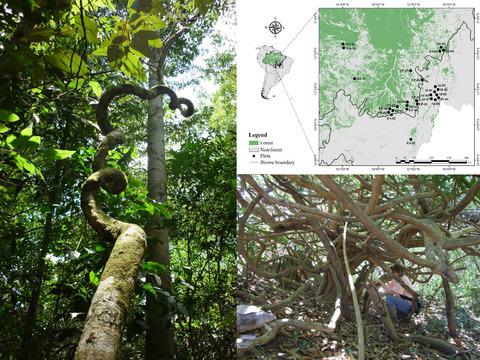Our official English website, www.x-mol.net, welcomes your
feedback! (Note: you will need to create a separate account there.)
Causes and consequences of liana infestation in southern Amazonia
Journal of Ecology ( IF 5.3 ) Pub Date : 2020-07-08 , DOI: 10.1111/1365-2745.13470 Simone Matias Reis 1, 2, 3, 4 , Beatriz Schwantes Marimon 1, 2 , Paulo S. Morandi 1, 2 , Fernando Elias 5 , Adriane Esquivel‐Muelbert 3, 6 , Ben Hur Marimon Junior 1, 2 , Sophie Fauset 7 , Edmar Almeida Oliveira 1, 2 , Geertje M. F. Heijden 8 , David Galbraith 3 , Ted R. Feldpausch 9 , Oliver L. Phillips 3
中文翻译:

亚马逊南部南部藤本植物侵染的原因和后果
更新日期:2020-07-08
Journal of Ecology ( IF 5.3 ) Pub Date : 2020-07-08 , DOI: 10.1111/1365-2745.13470 Simone Matias Reis 1, 2, 3, 4 , Beatriz Schwantes Marimon 1, 2 , Paulo S. Morandi 1, 2 , Fernando Elias 5 , Adriane Esquivel‐Muelbert 3, 6 , Ben Hur Marimon Junior 1, 2 , Sophie Fauset 7 , Edmar Almeida Oliveira 1, 2 , Geertje M. F. Heijden 8 , David Galbraith 3 , Ted R. Feldpausch 9 , Oliver L. Phillips 3
Affiliation

|
- Lianas, a key component of tropical forests, can limit growth of trees, impacting both the structure and functioning of forests, and are expected to benefit from fragmentation and potentially from global climatic changes. While it is critical to understand the impacts of liana infestation on contemporary tropical forests across large geographical areas, to date most liana studies have been focussed on single or few sites.
- We measured and quantified liana infestation of 16,066 trees with diameter ≥10 cm in 27 plots distributed across southern Amazonia, a region characterized by substantial ecological and environmental variation and environmental change. We examined the influence of potential drivers of liana infestation at the plot, species and individual tree level. Additionally, we evaluated the effect of liana infestation on tree growth.
- More than half of all trees had lianas in their crown. At the plot level, infestation by lianas was driven by forest structure but not by the studied climate or soil fertility variables, though low levels of liana infestation were found in seasonally flooded forests.
- At the tree level, larger and stouter trees had a greater proportion of their crown infested with lianas. At the species level, trees belonging to intrinsically slow‐growing, dense‐wooded species were more susceptible to liana infestation.
- Liana infestation had a negative impact on tree growth, with growth of heavily infested trees reduced by 33% compared to non‐infested. The impact of liana infestation on tree growth was strongest for the best‐lit tree crowns, indicating that lianas act to reduce the large competitive advantage that well‐lit trees otherwise hold over their neighbours.
- Synthesis. Lianas are a pervasive and influential feature of the extensive forests at the southern edge of Amazonia. The degree of liana infestation in forests was closely linked to species‐level variables such as potential growth and wood density as well as the size of the individual tree. The growth of heavily infested trees was particularly restricted by lianas, and especially so for trees growing in otherwise favourable conditions, indicating the potential for lianas not only to reduce forest growth rates overall, but also to modify competitive hierarchies among trees within tropical forests.
中文翻译:

亚马逊南部南部藤本植物侵染的原因和后果
- 藤本植物是热带森林的重要组成部分,会限制树木的生长,影响森林的结构和功能,并有望从森林碎片化和全球气候变化中受益。尽管了解藤本植物侵染对整个大地理区域的当代热带森林的影响至关重要,但迄今为止,大多数藤本植物研究都集中在单个或几个地点。
- 我们测量并量化了分布在整个亚马逊南部的27个样地中的16,066棵直径≥10cm的树木的藤本植物侵扰,该地区的生态和环境变化和环境变化都很大。我们在地块,物种和单棵树的水平上研究了藤本植物侵扰的潜在驱动因素。此外,我们评估了藤本植物侵染对树木生长的影响。
- 所有树木中超过一半的树冠上有藤本植物。在样地水平上,藤本植物的侵染是由森林结构驱动的,而不是受研究的气候或土壤肥力变量驱动,尽管在季节性淹没的森林中藤本植物的侵扰水平较低。
- 在树的级别上,较大且竖起的树木的树冠被藤本植物侵染的比例更大。在物种层面,属于内在生长缓慢,茂密树木的树木更容易受到藤本植物的侵扰。
- 藤本植物的侵染对树木的生长有负面影响,重度侵染的树木与未侵染的树木相比减少了33%。对于光照最佳的树冠,藤本植物侵染对树木生长的影响最强,这表明藤本植物的作用是减少光照良好的树木比邻域拥有的巨大竞争优势。
- 综合。藤本植物是亚马逊地区南部边缘广泛森林的普遍和有影响力的特征。森林中藤本植物的侵染程度与物种水平的变量密切相关,例如潜在的生长和木材密度以及单棵树的大小。受藤本植物限制了重度侵染树木的生长,特别是在其他有利条件下生长的树木也是如此,这表明藤本植物不仅可能降低总体森林生长率,而且可能改变热带森林中树木之间的竞争等级。











































 京公网安备 11010802027423号
京公网安备 11010802027423号